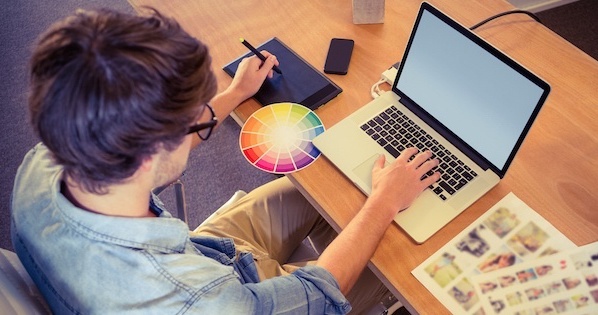
Each tool has a number of controls called options. So, if I want to add text not in a horizontal orientation, but rather in a vertical orientation, I can just slide down to the Vertical Type Tool in this flyout menu, and select it from there. And you'll see a flyout menu of related tools. You can click and hold any tool, like the Horizontal Type Tool here, that has a little triangle at its bottom right corner. There are more tools than you see on the face of the Tools panel. And in a moment, you'll see the name of the tool in a tooltip. If you're not sure what a tool is, you can just hover over its icon. Another important interface element is the Tools panel, which is located to the left of the Document window. And after I'm done using it to evaluate the tones in a photograph for example, I can close it by clicking the double pointed arrow here.

For example, I'll choose the Histogram panel. To open one of those panels, go up to the Window menu, and choose from this list of alphabetical panels, a panel that doesn't have a checkmark. There are some panels that aren't open on the face of Photoshop. I'll go ahead and select a blue swatch here in the Swatches panel, and that color will be applied when I use other color features, like the Brush tool. If I want to see the Swatches panel, I can just click its tab, and that brings it forward so I can use it. For example, here we have a panel group of the Color panel and the Swatches panel. Some of the panels are hidden behind others. There are more panels than just those you see in this panel column. Over to the right of the Document window are the panels, that have a variety of image editing controls. This is where you'll work on your images. The first interface element to get familiar with, is the Document window, which is right here, in the center of the screen. To follow along with this tutorial, you can open any image. Let's take a look at how Photoshop is laid out to help you get comfortable with your workspace. All as you'll learn to do, as you continue through this tutorial series. So, to finish creating a new document, click the Create button, and your new blank document opens in Photoshop, ready for you to add a photo, text, or maybe a shape. And these settings could be changed later in Photoshop if you need to. But sticking with the presets, takes the worry out of having to figure out technical details at the beginning. Any of the other settings on the right could be customized too. If you decide that's not exactly the size you want, you can type a different size into the Width or Height fields. Over on the right, all the details have now been set up for me, including the width and the height. I'm going to select this preset, the Landscape, 4 x 6. If you don't see one you like, there's an option here to view more presets: View All Presets. Next, choose one of the preset sizes in this section called Blank Document Presets. Photo, Print, Art & Illustration, or one of these others. To find one that works for you, first select a category of documents from the top of the window. Photoshop comes with a lot of Blank Document Presets that you can start with. So, this time, from the File menu, let's choose New. You might do that when you want a blank canvas on which to draw, or on which you want to place some images.
#HOW TO PHOTOSHOP ON PC HOW TO#
Let's leave those open and talk about how to create a new image from scratch. If you want to see another Open_Image, just click its tab. And the tab tells you the name of the image.

At the top of the document window, there is a tab for each Open_Image.

Both selected images open into Photoshop editing workspace, which is called the document window. If you want to open more than one image at a time, hold the Command key on a Mac, or the Ctrl key on Windows, and select another image file. You could select one of the practice files that come with this tutorial, as I'm doing, or you can select an image of your own.

#HOW TO PHOTOSHOP ON PC MAC#
That will launch your Mac Finder or your Windows File Explorer, where you'll navigate through your file system to an image file and select it. from the File menu, to open some existing image files into Photoshop. So even if your start screen isn't showing, you can always go up to the File menu at the top of Photoshop, and choose New. But there's another way, to get to these same commands from anywhere in Photoshop. button on the start screen and click, or if you wanted to create a new image from scratch, you could use the New. If you wanted to open an existing image, you could go to the Open. When you launch the latest version of Photoshop, you may see a start screen that looks something like this. The first thing you'll do in Photoshop, is either open a file or create a new file.


 0 kommentar(er)
0 kommentar(er)
